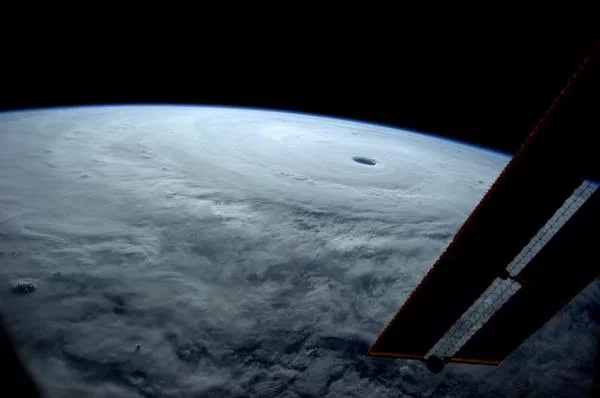News•October 10, 2014
Picture This: Monster Typhoon and Miami’s King Tides
With October comes Halloween, and this week was certainly full of some scary weather. Typhoon Vongfong spun up to monster size and strength in the Pacific, while strong winds knocked down trees in Massachusetts. Perhaps even more fitting to the upcoming holiday was this week’s blood-red full moon. Read on to find out what caused it and see amazing images of it and other notable weather and climate events this week.
Strongest Storm of 2014
Just a week after torrential rains from Typhoon Phanfone caused floods and mudslides in Japan, another typhoon, called Vongfong, looks to hit the country on Monday.
On Tuesday, when its winds reached 180 mph, Vongfong became the strongest storm of the year, and the strongest since Typhoon Haiyan devastated parts of the Philippines. Its strength was equivalent to a Category 5 hurricane (hurricanes are the same phenomenon as typhoons).
Typhoon #Vongfong has peaked with winds near 180 mph and a central pressure of around 900mb pic.twitter.com/gD1oXR0DXT
— Met Office (@metoffice) October 8, 2014
The structure and size of the storm exhibited in satellite images prompted Jason Samenow at the Washington Post’s Capital Weather Gang blog to call it a “wickedly beautiful” storm.
MT @NOAASatellites Satellite estimates Oct 9 at 03:55 UTC: #Vongfong's eye is approx 50 miles wide as nears Japan. pic.twitter.com/VURg3pzc77
— WMO | OMM (@WMOnews) October 9, 2014
Meteorologists weren’t the only ones impressed. Astronaut Reid Wiseman, currently aboard the International Space Station, tweeted a photo of the storm and said, “I’ve seen many from here, but none like this.”
Super Typhoon Vongfong over the Pacific Ocean in a photo taken by astronaut Reid Wiseman from the International Space Station.
Credit: NASA

Massachusetts Microburst
On Wednesday morning, residents of Easthampton, Mass., discovered that strong winds associated with some severe weather had leveled thousands of trees in the area. But it wasn’t a tornado that caused the stunning scene, but a microburst.
Thousands and thousands of snapped trees on west side of Mount Tom in Easthampton Mass. pic.twitter.com/CaMzlUN5F6
— Ryan Hanrahan (@ryanhanrahan) October 8, 2014
A microburst, as Dennis Mersereau at Gawker’s The Vane blog explains, is a “sudden downward burst of wind from the base of a thunderstorm.” The winds pushing downward can reach 60 mph before they hit the ground and spread out in all directions, there reaching speeds up to 100 mph. That wind pattern leaves a damage signature that is distinguishable from the swirling pattern that a tornado leaves.
The National Weather Service later confirmed that the microburst in Easthampton reached speeds up to 100 mph over a path about 1 mile long and a quarter mile wide.
JUST IN: Strong microburst confirmed in Easthampton. 1/4 mile path, max winds 100mph: http://t.co/E8O5L4jQzopic.twitter.com/1JZs3PK5tV
— Eric Fisher (@ericfisher) October 8, 2014
King Tides Swamp Miami
As you’d expect, King Tides aren’t your ordinary, run-of-the-mill tides. They are the highest high tides of the year, and occur when the sun, moon and Earth are in line with one another and at their closest, amping up the normal tidal pull on the oceans.
In Miami, the King Tides can swamp city streets, and this year, city officials installed pumps to help keep the waters at bay. Their efforts aren’t helped by sea level rise, which has boosted water levels by 4.5 inches locally just since 1996.
Here is bay side of campus during this morning's very high tide. No beach again! #KingTide@UMiamiRSMASpic.twitter.com/2G7K6oBXcQ
— Brian McNoldy (@BMcNoldy) October 9, 2014
Blooood Moon
The moon pulled another neat trick this week, appearing a Halloween month-appropriate shade of bloody red during a total lunar eclipse.
Gorgeous #LunarEclipse over #NYC's @EmpireStateBldg this morning. #fullmooneclipse#moonpic.twitter.com/KXsAKQS6Le
— Inga Sarda-Sorensen (@isardasorensen) October 8, 2014
Called a Blood Moon, the total eclipse happens only when the sun, moon and the Earth are in that perfect alignment that causes the Earth to cast a shadow that blocks the sunlight that would normally illuminate the disk of the full moon. The reddish color that gives the phenomenon its name happens because red light is scattered by the Earth’s atmosphere. Despite the easy explanation of this phenomenon, it might still send chills down your spine. Mwahahaha!
Clear skies over @YellowstoneNPS provided a great view of this morning's #bloodmoon#LunarEclipsepic.twitter.com/Vf9VTLEk47
— US Dept of Interior (@Interior) October 8, 2014
Photos: Lunar eclipse turns moon blood red over DC. Epic collection: http://t.co/daJd2xsHJN (Image: Caroline Angelo) pic.twitter.com/tIy7xWwk4n
— Capital Weather Gang (@capitalweather) October 8, 2014
